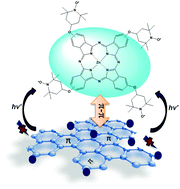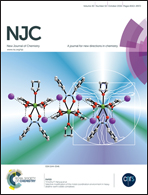Application of graphene quantum dots decorated with TEMPO-derivatized zinc phthalocyanine as novel nanoprobes: probing the sensitive detection of ascorbic acid
Abstract
Novel nanocomposites of (2,2,6,6-tetramethylpiperidin-1-yl)oxyl (TEMPO) derivatized zinc phthalocyanine (TEMPO-ZnPc) with graphene quantum dots (GQDs) or S/N co-doped graphene quantum dots (SNGQDs) were synthesized. The fluorescence of both GQDs and SNGQDs was quenched (“turned OFF”) upon non-covalent coordination with TEMPO-ZnPc. However, the emission of GQDs (or SNGQDs) was restored (“turned ON”) in the presence of ascorbic acid (AA) due to the selective and specific interaction of TEMPO-ZnPc with AA. Among the tested biomolecules and ions, only AA induced the restoration of the quenched GQDs fluorescence emission resulting in the “Off–On” mode of the GQDs. The “turn ON” fluorescence signal was modulated by different concentrations of AA and the limits of detection were in the nanomolar range of 0.2 nM and 0.8 nM for SNGQDs–TEMPO-ZnPc and GQDs–TEMPO-ZnPc, respectively. The quenching mechanism was elucidated based on Forster resonance energy transfer (FRET) in which the GQDs acted as the energy donor.


 Please wait while we load your content...
Please wait while we load your content...